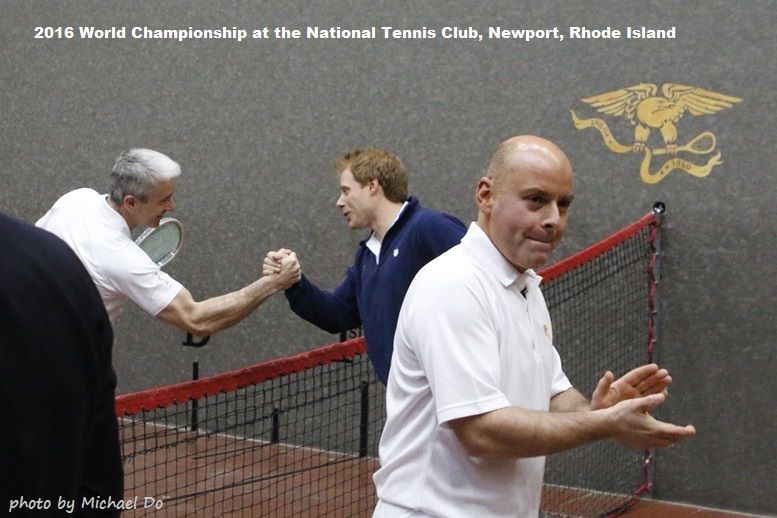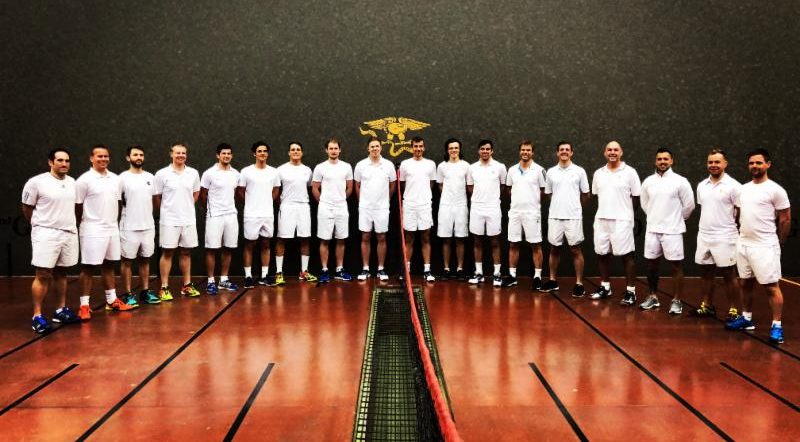by James Zug
The 2016 Men’s World Championship began with great pomp, circumstance and sadness at the National Tennis Club. Jonathan Howell, president of the International Real Tennis Players Association, introduced the challenger, Camden Riviere, the defending champion, Rob Fahey and the marker, Drew Lyons. B.J. Whitehouse sang the national anthems of both Australia and United States. Then silence descended among the hundreds of spectators, as everyone stood and honored the memory of Jay Schochet, the late torchbearer of tennis in Newport.
Both players wore bright sneakers—Riviere’s were red, Fahey orange—with orange shoelaces. Otherwise, all in white. Both looked quite fit—remarkably more fit than at their previous encounter two years ago in Melbourne.
Fahey won the toss and elected to serve. After raising his racquet to the various galleries, he sent a railroad spinning along the penthouse. Riviere hit a cut volley crosscourt. Fahey cracked the ball down the line and after trading strokes Riviere took the ball off the tambour and sent it into second gallery.
The match was off. Riviere, now in his third challenge for the world championship, got into high gear a bit faster than Fahey (although he double faulted in the second game). At 3-3, he burst into the lead and went up 5-3. Fahey clawed back to 5-4, saved two set points but couldn’t push through and Riviere took the first set.
Initially, Fahey seemed out of rhythm. He asked for the lights to be turned off in the side galleries. He stopped when there was noise in the clerestory gallery. He wiped his forearm on the wall below the dedans. He missed targets, balls going up onto the penthouse.
Two years ago in Melbourne, Riviere grabbed the first two sets and that happened again here. Riviere jumped to a 3-0 lead and never looked back, 4-1, 5-2 and taking it at 6-3. Both men served railroads on first serves and demi-piques on second serves. Towards the tail of the match, both moved to giraffes.
The third set was the shortest of the four. From 2-2, Riviere cruised to grab the next four. Riviere’s footspeed was astonishing. At least three or four a game, a Fahey putaway turned out not to be, as Riviere beautifully retrieved. Was it Riviere’s ability to get to balls or a slight lack of severity from Fahey? Either way, Fahey often had to win a point twice and often even then he wouldn’t. If he couldn’t finish off points on the floor, he also couldn’t hit targets: in the second set, for instance, he didn’t force a single ball into the dedans. More than once, Fahey shook his head in annoyance at his errors and lack of precision and cut.
The fourth set was vintage Fahey. The grinding stopped. For the first time in the match he was able to put some clear water between himself and Riviere, going from 2-all to 4-2. His railroad got more venomous, his forces more intimidating. He snagged chases with greater ease. In the first set he achieved just three chases by galleries, the second set just two and the third set just one. In the fourth set, he had thirteen—a major shift in strategy and execution. He sent the ball into the grille four times over the first three sets; he did it four times alone in the fourth set. His iron wrist sent viciously cutting balls crosscourt from whence they came. At one point he did a Jacob’s Ladder, climbing up the main wall to cut off a volley headed for the grille. Up 40-0, Fahey appeared on the verge of a quick set.
Riviere didn’t succumb, however. He played well in the fourth set. He still found targets in the last set: two winning galleries, two forces into the dedans, two grilles He jumped back to 4-4. Fahey went up 5-4. Then an epic finale. Fahey failed to clinch three set balls—one with a rare chase-off—and Riviere failed to clinch two game balls. Finally, on the fourth set ball, Fahey escaped after Riviere netted a forehand drive. In his previous twelve world championships, Fahey had always taken the fourth set and it was no different today.
Riviere won three sets, Fahey won one: 6-4, 6-3, 6-2, 4-6.



